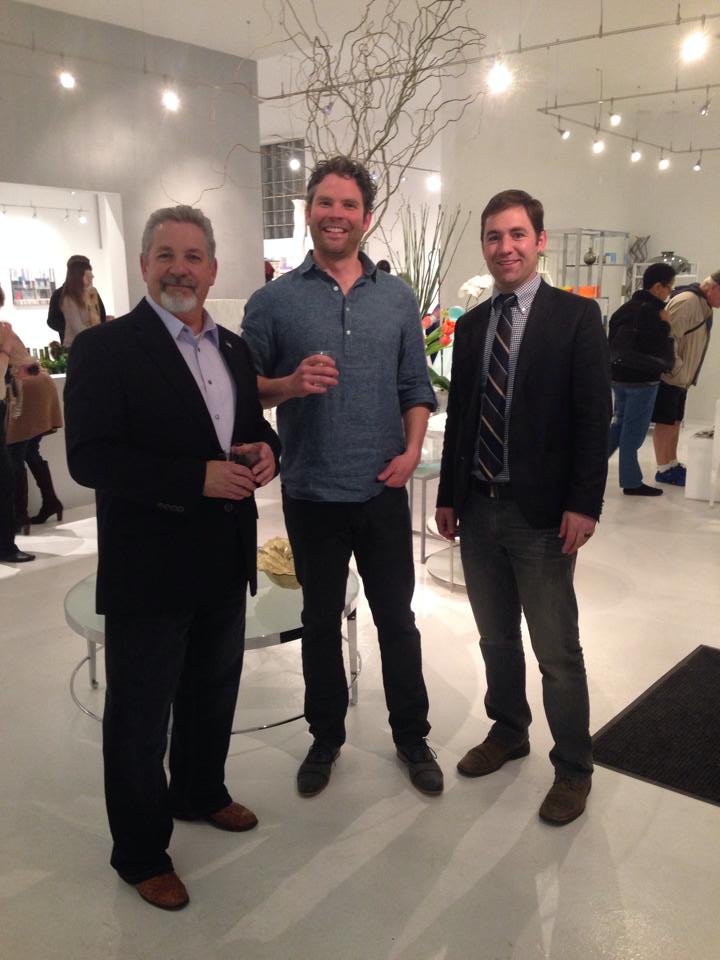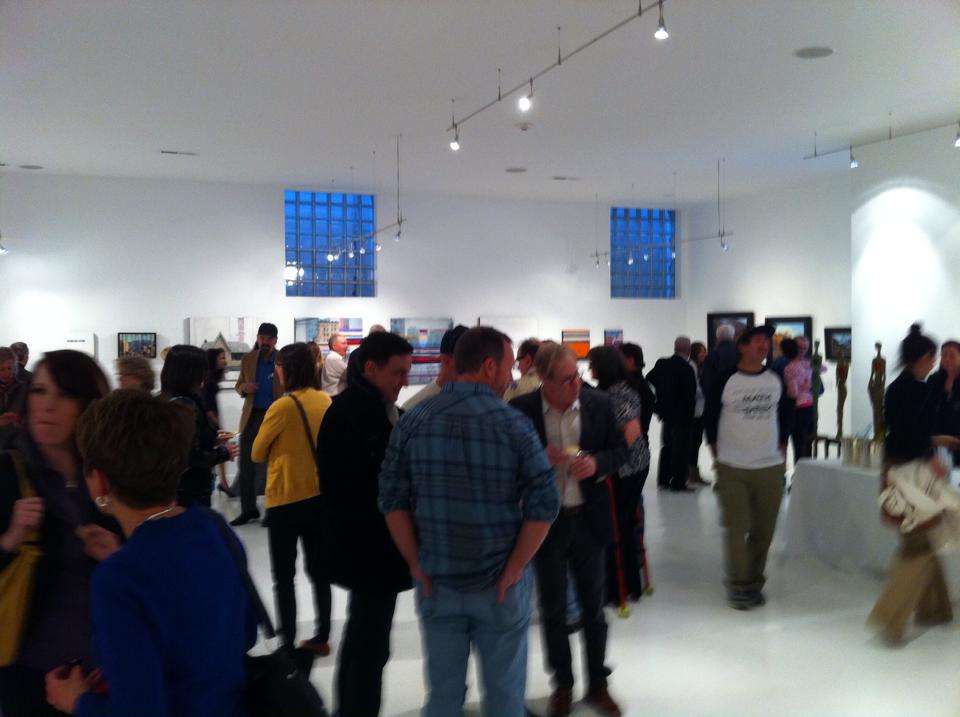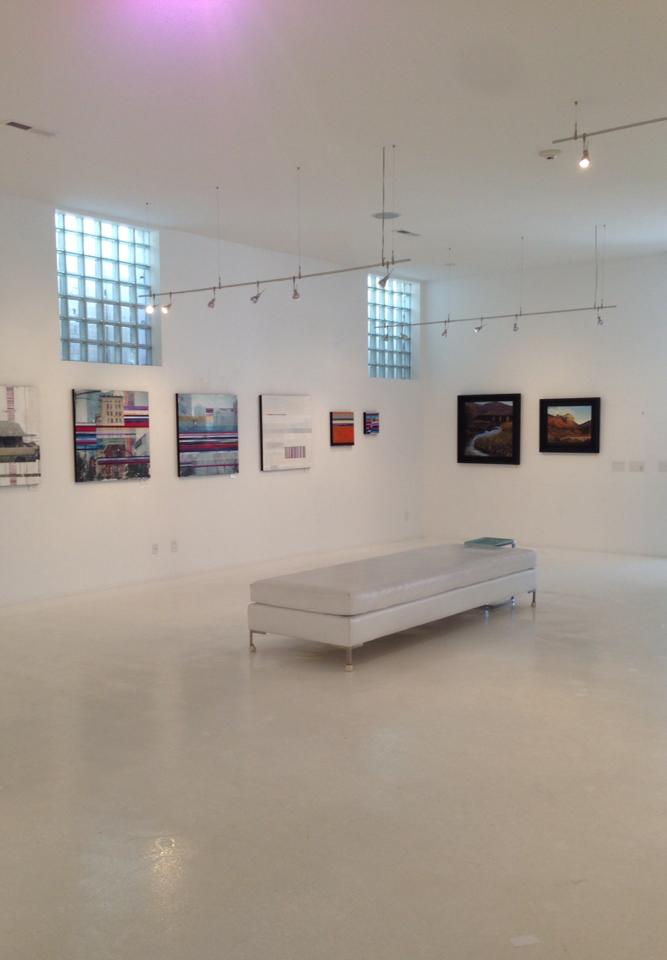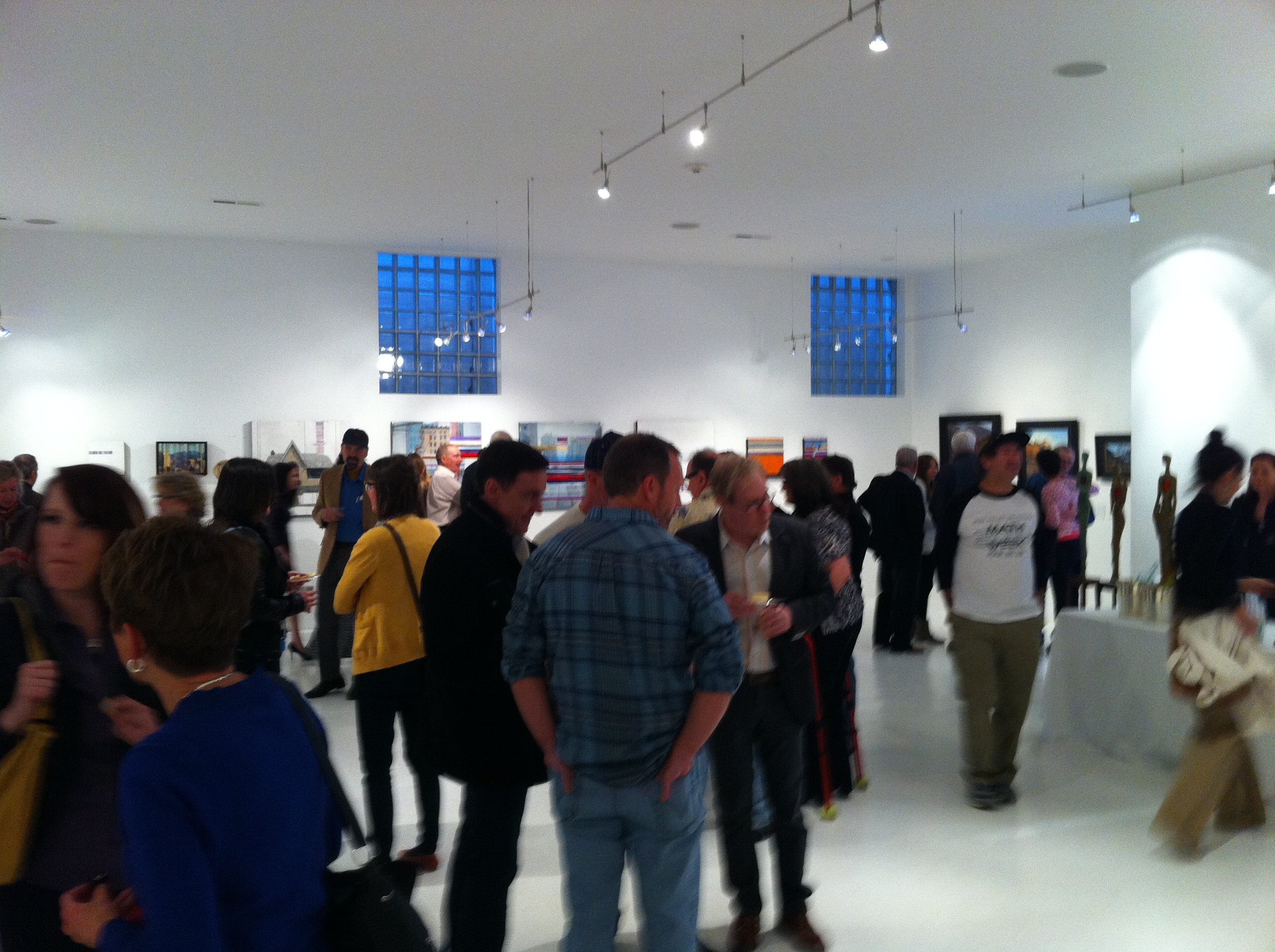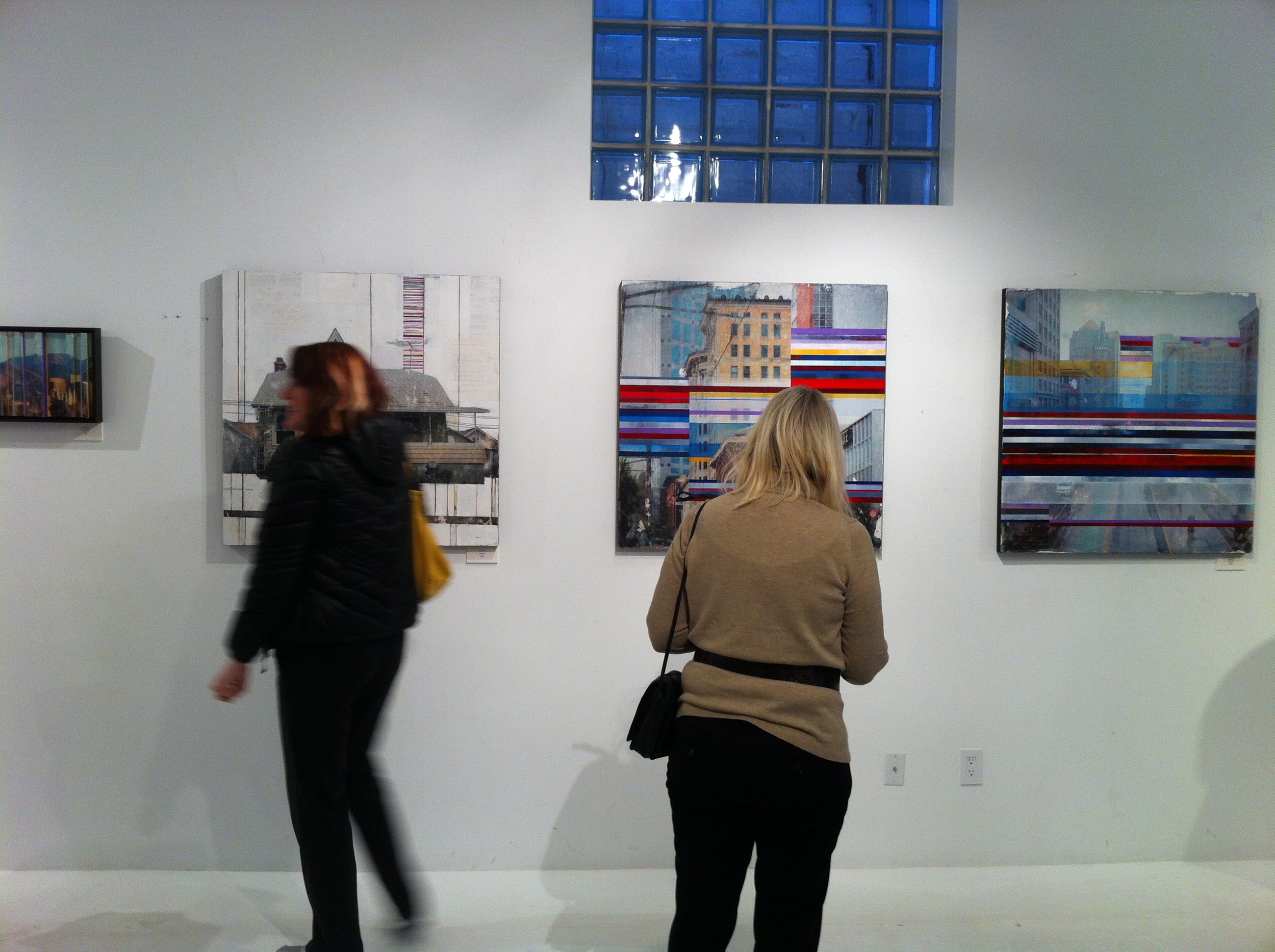I'm excited to invite you to the opening of the show with Leslie Graff and Trenton Higley. It will be Friday, March 20th from 6-9PM. The event is casual and family friendly. 15th Street is located at 1519 South 1500 East in Salt Lake City.
Salt Lake Magazine Article
A few years ago I had my first solo show at the Kimball Art Center in Park City. The Director of the center, Robin Marrouche, purchased a piece for her private collection. Robin is one of those people who I can always look to or think about when I need inspiration. Here is a link to an article about her and her husband Nassir. The article is nice, but it doesn't do the slightest justice to the incredible people these two are nor the accomplishments they have achieved.
Utah Arts and Museums Acquisition
It's an honor to have had this piece acquired by the State of Utah for their permanent collection!
“Statewide Annual ’14: Painting & Sculpture”
I'm thrilled to have this piece accepted into the Utah Division of Arts and Museum's statewide annual show! The exhibition is up from November 21st 2014 to January 9th 2015 at the Rio Gallery in downtown Salt Lake City.
Springville Museum of Art's 29th Annual Spiritual & Religious Art of Utah Exhibition
I'm very happy that these two pieces were accepted into the Springville Museum of Art's annual Spiritual and Religious Art of Utah show! The exhibition will be up November 19, 2014 - January 18, 2015.
The Prayer II 12" x 24"
Tree of Life 12" x 12"
The show opens Friday, October 10 from 6PM to 9PM at Evergreen Gallery, 3229 South, 2000 East, Salt Lake City
Between Summer and Winter at Evergreen Gallery
"Arty" award from City Weekly
I'm honored to be recognized by Salt Lake City Weekly with an Arty award. Here's an explanation from the paper:
"Art begins, quite simply, with nothing: It is the writer's blank sheet of paper or computer screen, the painter's canvas, the filmmaker's empty camera hard drive, the choreographer's stillness contemplating an initial act of motion. Every new act of artistic creation begins with time—to some, it must feel like an eternity—when there is no idea whatsoever what will happen next. But then something does happen. Whether it's a muse or God, genius or dumb luck, the artist finds the moment when the path becomes clear. Or, at least, clearer.
"Art is an act of bravery. And not just in the sense of putting often-soul-baring work out there to be judged—and sometimes rejected—by the world, but in the sense of being willing to face the blankness before creation, the wondering if the perfect creation might happen this time, even as it so rarely lives up to the vision in the artist's head. It's a leap off the edge of the world when you really don't know what will be at the bottom.
"City Weekly's Artys Awards may only recognize a finite number of artists in any given year, but we see this as a way to celebrate creation wherever it's found in this state. We congratulate those honored by our readers and our contributing writers, but we also congratulate everyone who takes that leap. And we keep asking our readers to join them on those journeys."
- City Weekly, September 10, 2014
My award can be read about here.
Review by Ehren Clark
“Points of Departure”
New Work by Justin Wheatley: 15th Street Gallery, March 21
By Ehren Clark
Before I was ready to write this piece on Justin’s work, his language of existentialism had become fluent to me. I would see a house, or a variety of house, city buildings of all shapes and sizes, monuments such as bridges and street laps, water towers and skyscrapers. The language I was speaking was the same as Justin’s, the language of existentialism, a language of questioning, questioning the reality of truth opposed to artifice. The artificial is found in the external and apparent by its physicality. Truth lies internally and the mystique of this language is that it is an open inquiry as the interior can never be in reality be made manifest with truth, the artifice of the exterior is no absolute signifier of the reality of what lies beyond it. The engagement with the mechanisms of these works such as age, color, style, iconography, graphics, etc, all are a play on significance leaving one guessing but truth to these questions have no answers.
From this vantage point the language, the interrogation, has been looking inward, an alternate approach finds the viewer looking outward and focusing on the physicality of the structural language of any canvas. The new works transcend the monumentality of hoses, city buildings, monuments, and skyscrapers and the presence of age, color, style, iconography, and graphics. With the older works the monumentality and physicality we indicative and mattered less than the truth of what lie beyond and the presence of qualities ranked lower in importance than the presence of the possibility of truth they signified, in the new works these are not only paramount the new works function as meaning is discovered by the full access to structure both physical and metaphysical and the structure taking the viewer beyond to question universal realities and universal truths. This is a different art and a different language and it is exciting.
A new piece yet to be titled boldly expresses this philosophy and is a journey of discovery. The structural points of departure in this canvas are limitless but can be reduced to two generals, and in any given structure, there is never a particular without an “other.” Nothing in the universe exists detachedly. Everything is connected to everything. So this canvas is ideal for a construction of this philosophy and a development of this language in these new works.
Two particulars chosen at random; the top tier of violet set against the pyramid tower and to the far right of the composition. Another particular; this a larger structure with components within it, the train platform half hidden with a hazed layer over it. What could their connectivity be? Experiential perhaps? I see a middle-aged lawyer on the platform on one of our infamous Utah “foggy” days. He stands there with a briefcase, the man who has everything, and says to himself, “What am I doing? I have nothing. I am barely alive. My only reason in life is to allow criminals having willfully committed crimes receive lesser sentence all for the sake of money.”
With a feeling of heaviness unlike any feeling he has ever known and a heart that is racing, he looks up to the south to a more open sky as he feels he cannot breath. In that sky there is an ethereal band of purplish hue cast on a level cloud reminding him that there is more to life than the world and there is more to the world than making money.But at the same time there is some relief and he feels he can breath again. He has seen ethereal beauty, he has seen it in nature, he knows there in more to life than the world there is more to the world than making money. He gets chills as he knows he can start again and he knows his possibilities are limitless. Experiential is also a wonderful manner to view any of Wheatley’s new works and feel very much involved with amazing dynamics ripe for analysis of meaning with infinite universal possibilities of significance. Structure, physical and metaphysical, is not just skin deep.
I'm excited to be a part of this show! The opening reception is September 19th from 6 PM to 9 PM at 1519 South 1500 East in Salt Lake City.
15th Street Gallery Group Show
I'm excited to be a part of this show! The opening reception is September 19th from 6 PM to 9 PM at 1519 South 1500 East in Salt Lake City.
Read MoreRelevant 2014
I'm excited to be participating in Relevant 2014 at the Kimball Art Center in Park City! I have three pieces in the show, which runs from August 15 to October 26th.
Read MoreSpringville Museum of Art Spring Salon
I was thrilled to find out last week that the two pieces I entered into the Salon were accepted. I was even more excited to find out one of them received the Jurors' Third Place Award! I'm grateful and humbled that the jurors recognized the piece. It is one that I love for it's simplicity and for its depth. The museum is full of work that could have easily received the same recognition.
The Review is In
Well,the review is in, but the show is also no longer up. A big thanks to 15th Street Gallery, everyone who came to see the work, and City Weekly and Ehren Clark for the positive review.
The 15th Street Show
The opening at 15th Street was a huge success. Special thanks to Lucy for making it happen and to everyone that came!
The postcard
March 21 Show
I'm thrilled to be a part of this show. I'll have ten new pieces that I have been working on for several months.
Art for Sale
Art For Sale: Rethinking of Convention and an Investment in Interpretation
Baseball cards. We buy them and collect them and trade them and
idolize them. But what are they, really? A fantasy? A dream? A hobby?
Appropriating baseball cards for sale is an answer to one of the many
questions posed at the beginning of this project. What is the value of
the card? What is the value of art? It is also an attempt at poetic justice:
irony. Any value the cards once had diminishes with the mass production
of greedy companies.
Any value that these cards that I spent so much money on as a kid, I have
reconciled with and accept the devaluation as the cards are now torn from
the sacred condition of mint, and any value left in the tradition of “look
but don’t touch,” is reconditioned and recontextualized from the original
purposes of being hung on a wall, stuffed in a closet, hidden in a vault.
To be collected. Collecting is the irony that marries the original purpose
of these cards with their new value as works of art. The difference is that
although any monetary value these may have had as collectable works of
mass consumerism is nullified, the art that I have created does, however,
have its qualities as works of art: they have meaning.
Like my work in general, I have taken the cards out of the context of the
traditional and have replicated that tradition into a new context for the
cards that deconstructs that tradition and in the new context, each card
is a question on consumerism, mass commodity, what is value, what is
phenomenon behind the cards that causes them to have quantitative
value? What is the motivation that drives this consumerism and the
fanaticism of something that really is just a game but created into a world
of obsession and frenzy that goes along with it? My cards may have lost
their monetary value of commodity, I took that chance, but they are a
“Rethinking of Convention and an Investment in Interpretation.”
A critic's perspective on Near Mint/Mint
This was posted on the Facebook page "Utah's Art Critic: Ehren E. Clark," on January 25:
Justin Wheatley: Cards, Cards, Cards and Deconstruction
I have a very good friend whom those of you in the art community will need no introduction to, Mr Justin Wheatley, who is in a conundrum and I feel this is an ideal time for Utah’s Art Critic, AKA Ehren E. Clark, to lend his good buddy a hand, which is what good friends do, right?
Firstly, what many of you who understand Wheatley’s art is, is that he is at root an existential artist, or at least, an artist who probes questions about the true nature of reality, especially as it applies beneath the surface. This is why so many of you know Wheatley’s homes that were an early development, then to larger structures, buildings in cities, bridges including the Manhattan. Most recently at a triumphant show of work at Finch Lane this spring, Wheatley chose to paint more nebulous buildings, structures, and the idea of ambiguity in a home was emphasized. Why, might one ask, is the reason for all of this attention on homes and building structures?
The truth of the matter is that when questioning human existential being, what more elemental in terms of form to provide a launching point in asking paradigmatic questions about human reality than the home, the city building, the bridge, and most certainly the nebulous structures that were featured recently?
It is the skin to the body. One looks externally to ask about the internal and quite often, elements that are less than physical or quantifiable can be considered when looking externally, more than often, in fact. What is the temperament of this person? Are they kind or not? Are they to be approached or should one stay away? Do they look generous enough to offer the time or give directions or are they the sort to rudely turn away? These qualities of character are just as easily perceived than the more physical such as is he attractive to you? What age is she? Is he physically fit? Is this person healthy or sickly? Is this person from appearances wealthy or poor or somewhere in the middle? Do they groom and take care of themselves?
Often, the positive attributes of the former will coincide with the positive attributes of the latter but of course this is never an absolute case and there are always unanswerable questions about an individual when just looking at them.
This is the same kind of philosophy of humanity Wheatley is presenting when focusing on an exterior of a home etc. A home or a building may have external attributes that cause one to assume characteristics about the goings on inside. A well kept garden on a neatly trimmed home indicates a well kept family or individual. The same for a building, that implies the office space or business ethics maintain discipline and those involved are the same. But is this always the case?
Of course not. Even the most charming or even grandest of homes might domesticate a living situation with someone who is entirely unfriendly, rude, anti-social, unwilling to contribute, to serve, to give of themselves, these homes can house the worst kinds of individuals just like the opposite, a meager and unkempt home may inhabit someone who is generous, kind, charitable and good, but may have an equally meager income due to elements entirely not of their own doing, a college student, or a hipster! They could be disabled, depressed for being alone, aged, sick, unloved. The building might be in a state of decay because the occupants are not able to pay bills for reasons entirely disparate from any association with their own character.
It seems that these anachronisms are the kind which Wheatley is most interested in and the questions of the non-absolute, unanswerable, that we simply can never know by exteriors but make this investigation so provocative when seen with Wheatley's eye for particulars of ambiguity, difference, irony, inconsistency, and a vagueness of “what is,” which apparently for Wheatley, “never IS.”
Bearing this essential philosophical paradigm in mind, it then becomes possible to enable the act of aid that led to this discourse. The situation is that Wheatley has many, many thousands of baseball cards and is interested, has already begun, using them in ways that can further his artistic milieu and function as an extension to his primary body of work. In the initial stages, Wheatley was at a loss as to how he might facilitate this and incorporate the project into his work and make something of it significant. After some difficulty, he has arrived at a point that finds these baseball cards and his treatment of them in line with his aesthetics in general, and I would like to take the opportunity to dictate to Wheatley here just why I see this latest jaunt as a successful one and one that is in tune with his philosophy, and how, and that this is a manner that would be wise to persist in.
I will discuss the four cards Wheatley posted on Facebook just days ago and why I feel they are a complete success and fall in line with his essential philosophies.
The first is a basketball card. Wheatley has cut some of the length off of each side of the inner photograph and then applied the two outer edges so it appears this is an elongated basketball card, but for the sake of art, we know very well it is not. In this play of the shape of the card, the elongation, Wheatley is deconstructing the absolute shape that is ubiquitous in sport and trading cards, and in this, with this athlete that is already so elongated himself, presents a synthesized version of the tradition card and shown an alternative, stylistically congruent, that presents a stopping short on the fundamental nature of the card and begs the question of just why does it have to be so and what is the reality of this century or so old tradition that has maintained the card be one shape? Is there anything to it at all besides tradition? Apparently there is as this card is so aesthetically pleasing.
The second card is another deconstruction. Wheatley presents a card that has been manipulated by placing one half of the card a male figure from the Star Trek Next Generation series and on the right a female. The card still functions and has even more appeal now with two popular figures instead of one, but on the card and even broader, in the media, how do we perceive certain characters and certain characteristics when identity is as real as the mutation of the two figures… not very.
The third card is as equally provocative and deconstructive. Here we have a popular baseball player, whose head has been cut off, and the top strip reattached to give it a semblance of something purposefully made. Here, Wheatley is presenting a major commentary that again, hinges on identity, and asks, is it the game we love or is it the sports hero, all of the hype… and there is so much hype?
If you were to say the fourth card is similar to the first you would be right only in that it portrays basketball. Everything else is different. Wheatley has not carefully cut the sides and reapplied the borders but cut right down the middle of the athlete, something imaginably blasphemous to any lover of basketball cards and especially a fan of this athlete. But it is a total defacement of the card that has been brutalized. Is this taboo? Are such cards a sacred part of our culture where such things just should not be done? We all might have our ideas on this but Wheatley has done it and unashamedly presents the case that invokes either a devil may care attitude or hot blood, never the less, it is the artist who takes the risks and risks come with their cautions.
In all four of these cards, the key element that is being officiated here is classic deconstruction. In the first, the very structure of the card is being deconstructed, the second, identity, in cards and in the media, the third, of sports and the idea of hero and celebrity or “just a game.” The fourth was a deconstruction on the sanctity of the card itself and the injury to the player who is being defaced, should this be taboo just as American as anti-flag burning or defacing the dollar bill.
This discussion has taught me more than I had already learned about Wheatley, as he is, from the many writings I have on him thus far as can be seen by the abundance on this page and many published, my favorite subject, as there really is no end to the investigation of his ever developing work. But the element of deconstruction in all of Wheatley’s work being paramount to the questioning addressed throughout this discussion, that we, as viewers, are presented with a duality and what the synthesis might be is the core of the work... this it so exciting!
With the cards, if Wheatley, “Hi Justin!” can maintain his “smarts” and his “invenzione” as they say in Italy, this construction, which is an actual means to a deconstruction, is something brilliant and provocative and completely attuned with the entire oeuvre and is less an appendage and is more an organic continuation of a body of work that is already airtight… and oh so fine. Can’t wait till Friday friend. EEC4
Remnants of a 1991 Fleer Ultra Steve Atwater, a 1991 Fleer Jerry Rice, and a 1991 Fleer Grant Feasel.
Near Mint/Mint: The Dust to Dust Series
The Dust to Dust series is a direct challenge to the idea of mint condition. I wanted to find the anti-mint. The complete opposite. I started by taking a 1991 Fleer Jerry Rice football card and sanding it down to dust and small pieces of paper. I then took a 1991 Fleer Ultra Steve Atwater card and cut it up into tiny pieces with scissors. For the third card, I took lit a 1991 Fleer Grant Feasel card on fire and collected what was left. I think the results are all more intriguing and beautiful than the original object and consider this series a success.
The Critique Cards
A few days ago I participated in a critique with ten other people. As part of the critique, I explained my Near Mint/Mint project and asked everyone in the room to participate. I handed everyone a baseball card and a sharpie. They were instructed to sign the card with there name, alter it in whatever way they wanted, and pass the card to the right. We did this until each card had passed through the hands of each person. The participants included Namon and Katie Bills, Steven and Sarah Stradley, Ehren Clark, Heather Teran, Liz Matthews, Shawn Stradley, a gentleman name Brian, and Justin and Camille Wheatley. These are the results, front and back:
Splice
This series is influenced by artist and art educator Jorge Lucero. The images used in sports cards are carefully placed inside a small frame. I found it rewarding to remove and adjust parts of the frame and images to create new interest in photographs that are repetitive and lacking in creativity. Below are four examples from this series of 100.
New Painting: Behind
35" x 35"
Mixed media








